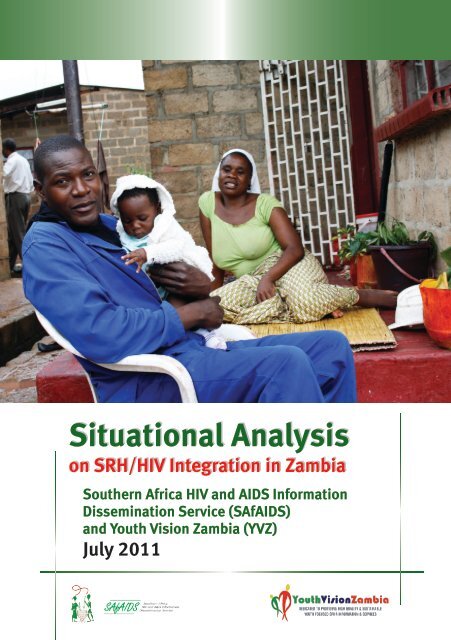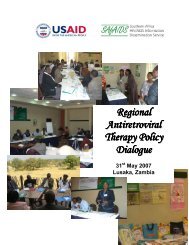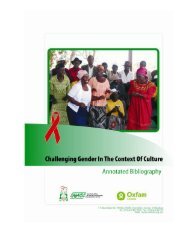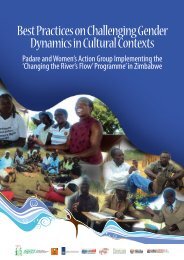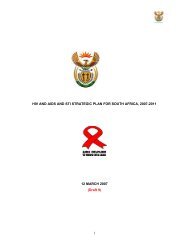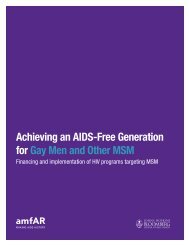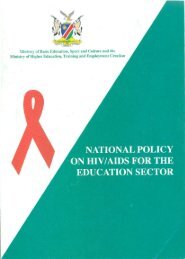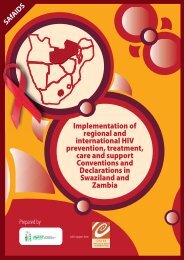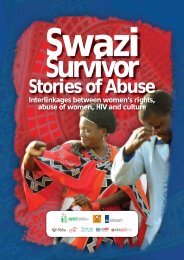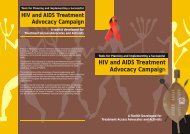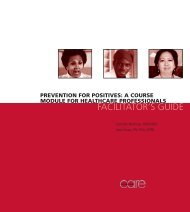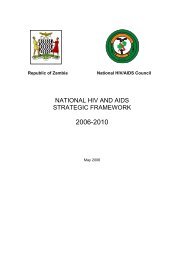Situational Analysis Situational Analysis - SAfAIDS
Situational Analysis Situational Analysis - SAfAIDS
Situational Analysis Situational Analysis - SAfAIDS
- No tags were found...
You also want an ePaper? Increase the reach of your titles
YUMPU automatically turns print PDFs into web optimized ePapers that Google loves.
<strong>Situational</strong> <strong>Analysis</strong>on SRH/HIV Integration in ZambiaSouthern Africa HIV and AIDS InformationDissemination Service (<strong>SAfAIDS</strong>)and Youth Vision Zambia (YVZ)July 2011
Findings of the Rapid AssessmentTable of Contents1.0 Introduction..........................................................................................41.1 Study Methodology.....................................................................................41.2 Summary of the findings..............................................................................52. Findings of the Rapid Assessment..............................................................6Overview of the Country Context................................................................6National Policies, Strategies and The Health Delivery System.................13The Global Fund.......................................................................................16PEPFAR/GHI............................................................................................20Civil Society Organizations Engagement...................................................21Programs around RH/HIV Integration.......................................................24Key stakeholders and partners.................................................................29Government Funding for RH/FP and HIV/AIDS...........................................29RH/HIV integration progress and challenges.............................................30Strategic advocacy entry points................................................................30References.............................................................................................322 |situationanalysis
Findings of the Rapid AssessmentList of AbbreviationsAIDSANCARTCCMCDCDHSFPGFHIVMNCHNGOOIGPEPFARPMTCTRH<strong>SAfAIDS</strong>STITBAUSGVCTWHOAcquired Immune Deficiency SyndromeAntenatal CareAntiretroviral TreatmentCountry Coordinating MechanismCenter for Disease ControlDemographics Health SurveyFamily PlanningGlobal FundHuman Immunodeficiency VirusMaternal, Neonatal and Child HealthNon-governmental OrganisationOffice of the Inspector GeneralPresident Emergency Plan for AIDS ReliefPrevention of Mother to Child TransmissionReproductive HealthSouthern Africa HIV and AIDS Information ServicesSexually Transmitted DiseasesTraditional Birth AttendantUnited States GovernmentVoluntary Counseling and TestingWorld Health Organisationsituationanalysis |3
Findings of the Rapid Assessment1.0 IntroductionGlobally, there is a call to integrate Reproductive Health and HIV services. The Glion callto action on family planning and HIV/AIDS in women and children in 2004 and the 2006UN Political Declaration on HIV/AIDS, which challenged the global health community toforge closer linkages between Reproductive Health (RH) and HIV through better policy andprogramme coordination are some of the landmark global events that has ignited globalcommitment to ensuring that RH and HIV services should no longer be treated as separatevertical programmes but should be integrated. In Zambia, the integration of HIV and RH isnecessary because it will not only contribute to cost effectiveness and maximize the limitedresources available to provide these services but will also enable people particularly those inrural areas to access and use RH and HIV services at one stop centers. For instance, peoplethat go to health facilities to access family planning and antenatal care can also access otherservices such as HIV testing and prevention of mother to child transmission in one placeinstead of being sent away to come back later for another service or being referred to anothercentre all together. Similarly, people living with HIV who have special needs that intersectbetween HIV and RH services will not only access HIV treatment but also be assisted to makedecisions on fertility, family planning, abortion, cervical cancer screening through ART services.To contribute to the achievement of RH and HIV integration, <strong>SAfAIDS</strong> and Youth Vision Zambiain partnership with Population Action International commissioned a 15 days rapid situationanalysis to establish the current national baseline of existing national policies, HIV and RHintegration programmes and opportunities for advocacy for increased integration. The baselinewould serve as a basis on which to begin the implementation of the Integration Partnership inZambia whose aim is to increase country demand for RH and HIV integration-including provisionof RH supplies and advocate for increased resources dedicated to RH and HIV integration.This is the report of the rapid situational analysis which took place in June2011. The report is divided into two sections. This introduction section whichis followed by section two in which the findings of the study are summarizedin a table format as per the requirements of <strong>SAfAIDS</strong> and Youth Vision Zambia.1.1 Study MethodologyTo conduct the situation analysis, the consultant mainly used three approaches to generate theinformation contained in this report. The first was a literature review. This included a thoroughsearch and review of existing policies, national reports on HIV and RH services and reportsof selected organizations that have made efforts to integrate HIV and RH services in Zambia.The second approach was consultations with key national policy makers and implementersthat included representatives of the reproductive health team in the ministry of health, theNational AIDS council, Global Fund Principle Recipients, PEPFAR representative and Civil Societyrepresentatives. The third was discussions with service providers at three health facilities onein Lusaka and two in Ndola. During the visit to health facilities the consulting team also madeobservations of the efforts being made to integrate RH and HIV services in public health institutions.4 |situationanalysis
1.2 Summary of the findingsZambia is a landlocked country in Sub-Saharan Africa with a population of 13million (51% femaleand 49% male). Its average population growth rate is 2.8 percent. Total fertility rate is high atan average rate of 6.2 children per woman. Although infant and maternal mortality rate havebeen declining over the years from 168 per 1000 live births in 2002, to 119 in 2007 and 729 per100,000 live births in 2002 to 591 per 100,000 live births in 2007 respectively, it is still one of thehighest rate in the world. HIV prevalence in the adult age group of 15 to 49 has reduced from15.6% in 2005 to 14% in 2007; nonetheless it is estimated that new infections will increase from67,602 adults in 2006 to 72,019 in 2015. There are more women (16%) living with HIV than thereare men (12%). The high HIV prevalence, high fertility and maternal and child mortality ratesrequires that, RH and HIV services should be integrated in order to increase access to and use ofthese services at community level to accelerate on the gains that the country is positively scoring.There is no overarching policy for HIV and RH integration in Zambia. However significanteffort has been made to integrate RH and HIV services at service delivery level particularly inpublic health facilities. Currently, voluntary counseling and testing, Prevention of Mother toChild transmission, STI treatment and initiation of antiretroviral treatment have, to a limitedextent, been integrated in antenatal and post-natal care services. Similarly, STI treatment, VCTand ART have been integrated in male circumcision services at service delivery centers. VCT,STI and other maternal health related services are being integrated in family planning services.In spite of these efforts, there are challenges. The major ones relate to coordination of HIVand RH integration services. There is limited interaction between the National AIDS Councilin charge of HIV multisectoral response and the Sexual and Reproductive Health Unit of theMinistry of Health in charge of reproductive Health policy implementation. There is a needfor enhanced collaboration between the two bodies in order to have a coordinated approachto integration of program both at policy and service delivery levels. Secondly, integratingservices although helps to maximize the use of health workers and facilities it has broughtfurther challenges. There is a perceived increase in the workload on the few health workersavailable and has led to long waiting time for clients at health facilities. The other challengerelates to stockouts of some RH supplies particularly for family planning. While HIV suppliesseem to be consistently supplied, it is not the case for family planning supplies. There aremany occasions when there are significant stockouts that affect access to services. If notproperly addressed, these challenges may lead to reduction in the number of people accessingservices particularly in rural communities where people have to walk long distances to accessservices. In cases where people have to wait for long hours and they find that the suppliesfor the services they need are not available, they may not return to seek the service again.situationanalysis |5
Findings of the Rapid Assessment2. Findings of the Rapid AssessmentComponentsOverview of the Country Context• Populationdistribution by age,sex, urban/rural,etc.• Epidemiologicalsituation and needsrelated to RHand HIV (e.g. HIVprevalence by age,sex, regions, etc)Outline of Key PointsPopulationAccording to the preliminary report of the 2010 Census Zambia’spopulation is now 13,046,508 comprising of 51% female and 49%male. The regional distribution of the population shows that the61% (7,978,274) live in rural areas as compared to 39% (5,068,234)in urban areas. There has been a steady increase of the populationfrom an estimated 3 million at independence, to 5.7 million in1980 to 9,8 million in 2000. The average population growth rateis 2.8 percent. At that rate the Zambian population is expected todouble in 25 years. The 2007 Zambia Demographics Health Survey(ZDHS) estimates that 50% of the total population is aged less than15 years while only 3% are aged 65 years and over.• Access to healthservices/facilities• Fertility Rate• ContraceptivePrevalence Rate• Emerging shifts ortrends in:- Unmet needfor FP- Maternalmortality rate- HIV prevalenceratedisaggregatedfor women andpediatrics• ANC and PMTCTcoverageFertility rateZambia’s total fertility rate is 6.2, which means on average aZambian woman will give birth to 6.2 children by the end of herchildbearing years. The general fertility rate which is the numberof live births per 1,000 women of reproductive age is equallyhigh at 214 live births per 1,000 women. Fertility however differsbetween urban and rural communities and between educated andless educated people. In urban areas of Lusaka and Copperbelt forinstance, total fertility rate is 4.1 and 4.8 respectively while it issignificantly high in rural communities of Northern Province (7.9),Western Province (7.3) and Luapula (7.2). Educated women havea fertility rate of 2.4 as compared to those that have no educationwith a rate of 8.2. Wealthier women give birth to five childrenfewer than women in the lowest wealth quintile. Zambia has oneof the highest fertility rates when compared to its neighbouringcountries – Malawi with 6.0, Mozambique 5.5 and 3.8 forSwaziland and ZimbabweHIV prevalence• HIV prevalence in the adult population aged between 15 and49 is currently 14% which is a decline from 15.6% in 2005.6 |situationanalysis
Findings of the Rapid AssessmentComponentsOutline of Key PointsOverview of the Country ContextReproductive Health ServicesThe notion of Reproductive Health is so wide it being defined by theWHO to be “...a state of complete mental and social well being and notmerely the absence of disease or infirmity, in all matters relating to thereproductive system and to its functions and processes”. This is slightlydifferent from Sexual Health which is defined as “a state of physical,emotional, mental and social well being in relation to sexuality; it is notmerely the absence of disease, dysfunction and infirmity. It requires apositive and respectful approach to sexuality and sexual relationships aswell as the possibility of having pleasurable and sexual experience freeof coercion, discrimination and violence.”In Zambia, the most commonly mentioned reproductive health servicesare family planning, maternal and child health and sexually transmitteddiseases. There is limited evidence on aspects of RH that relate to sexand sexuality education at community level and adolescent sexualrights. More recently there is an increase in discussions relating tosexual rights of women as they relate to gender based violence inkeeping with the WHO definition of sexual health. This is evidenced inthe creation of the ministry of gender and the gender based violenceact that was passed in 2011.a) Family Planning• Information dissemination:In Zambia, information on family planning both its benefits as wellas the different types of methods used is almost universal. 97% ofall women and 98.8% of currently married women know at least onecontraceptive method. 99% of all men and 99.8% of married men knowany contraceptive method. This knowledge is relatively equal both inrural areas as well as in urban areas 99.8% in urban areas compared to98.4% in rural areas. People are more knowledgeable about modernfamily planning methods than they are about traditional methods.Condoms are the commonly mentioned contraceptive followed by pillsand then injectables.• Service provision Verses uptake and use:Family planning services are available in Zambia, provided throughgovernment and private sector health facilities and Civil SocietyOrganisations such as the Society for Family Health and PlannedParenthood Association of Zambia. There is a general feeling howeverthat the attention toward family planning has plummeted over the lastfew years. This has been attributed to changes in funding which ledto lack of focus on family planning and concentrated funding to HIVprevention. “We became obsessed with HIV that family planning hasfallen off the radar.8 |situationanalysis
ComponentsOutline of Key PointsOverview of the Country ContextFindings of the Rapid AssessmentYou know in the 1990s every where you went you saw a poster, therewere lots of radio programmes and community discussions on familyplanning. Nowadays you rarely see that.” Said one respondent.The distribution of family planning services is in uneven in Zambia; it ismore readily available in urban areas than it is in rural areas. In somerural areas such as Namanongo community in Chongwe District, theservices are non-existent. As a result uptake and use of contraceptionis higher in urban areas at 47% as compared to rural areas at 37%.Similarly, the more educated the woman the more likely they are to usecontraception (57% of those educated use contraception as comparedto 37% of those who are not).Overall, current uptake and use of family planning is low and estimatedat 30% which means 70% of women are not using any form ofcontraceptives. This is significantly lower than neighbouring countriessuch as Zimbabwe with 58.4% and Swaziland with 47.7%.The unmet need for contraception in Zambia is also very high. It isestimated that 29% of married women have no intention to want touse contraception in future and 5% are not decided.There are many reasons for not accessing family planning; traditionalreasons - people want to have children not only as security for thefuture in terms of labour and income but also as a way of continuingfamily lineage; misunderstanding of the side effects of family planningtechnologies e.g. Depo Provera was banned for a long time in Zambia.It was only approved for use in 2005. Family planning is viewed as aresponsibility of a woman hence men do not participate in effectivedecision making for family choice which in some cases frighten womento access family planning services.The other reason is stock outs of family planning products. A 2008study by JSI found that “across the facilities, stockout on the day ofvisit was common for most of the products, except for male condomsand Oralcon-F.” A three months analysis of stockouts also showed asimilar pattern – clearly indicating that stock outs are very common inhealth centres. The most available family planning products are malecondoms and Oralcon-F. Some products such as Microlut and Oristeratwere completely stocked out on the day of the visit and in the last 3months before the study visit. Stockouts were as high as between 70 to100 percent. Female condoms similarly have a very high stock out rateof up to 60%.situationanalysis |9
Findings of the Rapid AssessmentComponents10 | situationanalysisOutline of Key PointsOverview of the Country ContextThe stockout is due to various reason that include, lack of supplies at theMedical Stores (an organization responsible for distribution of medicines),miscommunication between medical stores and the district health office,miscommunication between health office and the health facilities andthat some health centres do not order certain products because they arenot popularly used in the communities where they are located.b) Maternal and Child HealthMaternal Mortality Rate declined from 729 per 100,000 live birthsin 2002 to 591 per 100,000 live births in 2007. Under five and infantmortality rates have also declined overtime from 168 per 1000 live birthsin 2002, to 119 in 2007, and Infant Mortality Rate (IMR) from 95 to 70 inevery 1000 live births.In spite of the declines in mortality rates, Zambia is one of the countrieswith the highest maternal and child mortality rates in the world. Forinstance comparing it to neighbouring countries, infant mortality rate inNamibia is 45 while in South Africa it is 43 per 100,000 live births. Highmortality rate accounts for a low life expectancy at birth of 51.3 years in2010.Antenatal Care: Access to antenatal care in Zambia is very high, 91%of women receive antenatal care from a skilled provider during theirlast pregnancy. In urban areas it is almost universal with 99% accessingANC as compared to 91% in rural areas. The higher the education of thewoman the higher the likelihood of accessing ANC – 99% of women witha secondary education and above accessed ANC services as compared to88% of women with no education. The 2007 DHS statistics show thatvisits to ANC clinics are sustained throughout the pregnancy with 60.3%of pregnant women going back over 4 times for their ANC checkups.However in spite of this high ANC attendance, there are not as manydeliveries that are occurring in the presence of a skilled health worker.Actually 52% of most deliveries happen at home with 43% occurring ina health institution. Home delivery puts the mother and baby at risk ofdeath during labour when complications start. The Zambian governmenthowever has developed a programmes aimed at increasing safe deliveriesat home. They have trained Traditional Birth Attendants (TBAs) who assistpregnant women to deliver safely. A programme called Safe MotherhoodGroups has been introduced in 24 Districts across the country – theseare aimed not only at helping mothers to deliver babies, but also atproviding comprehensive education to women regarding their Sexual andReproductive Health needs and available services. Both TBAs and SafeMotherhood Groups save as emerging opportunities through which RHand HIV services can be integrated at community level.
ComponentsOutline of Key PointsOverview of the Country ContextFindings of the Rapid AssessmentThe challenge is that of the trained TBAs only 10% are active in providingservices – a situation that needs to be improved.PMTCT is available in Zambia. The percentage of HIV-infected pregnantwomen who received antiretroviral to reduce the risk of mother-to-childtransmission has increased from 54.3% in 2008 to 60.9% in 2009. There hasalso been an increase in the number of HIV infected pregnant women eligibleto be on HIV treatment from 4,922 in 2008 to 11,507 in 2009. Challenges inPMTCT remain, including lack of male involvement in PMTCT which hinderswomen’s freedom to access PMTCT. Lack of male involvement is due to anumber of reasons ranging from cultural issues to placing PMTCT in ANCwhich is traditionally viewed as a service for pregnant women. An opportunityhere is to begin a process of integrating male reproductive health services inthe ANC programme so that PMTCT are part of the male health educationprogrammes. The other reason is limited access to services in rural areas.Due to shortages of both health facilities and staff (see work force below)many pregnant women do not access PMTCT when they are pregnant.c) Adolescent Sexual and Reproductive HealthAdolescence is a crucial period in human development. It is a period whenpeople pass from childhood to adulthood and they learn to understand notonly their sexuality but also their role in life. According to the 2009 ZambiaSexual Behaviour Survey (ZSBS), there is a decrease in the percentage ofadolescents (15-19 year olds) reporting to have ever had sex from 44% in2005 to 35% in 2009. More adolescent girls (41%) than adolescent boys(30%) reported having ever had sex.In spite of this high incidence of sex amongst adolescents statistics indicatethat adolescents have limited use of condoms. In the 2009 ZSBS only 31%of girls and 27% of boys used condoms at first sex. Condom use does notsignificantly increase amongst young adults aged between 15 and 24.The 2009 ZSBS reports that only 37% of young people reported using acondom with their last sexual partner. Adolescents in Zambia are awareof reproductive health services particularly family planning. An estimated21% of unmarried adolescents have ever used any contraceptive method.However teenage pregnancy is high. Overall, 28% of girls aged between 15and 19 have begun childbearing; 22% have had a child and 6% were pregnantin 2007. Adolescents in rural areas are more susceptible to getting pregnantat 35% as compared to their urban counterparts at 20%. Early marriage isalso very common. It is estimated that 16.9% of adolescent girls are marriedas compared to 1% of their male counterparts. There is therefore a need toaccelerate information, education and RH services for adolescents in Zambia.situationanalysis |11
Findings of the Rapid AssessmentComponentsOutline of Key PointsOverview of the Country Contextd) STI Prevention and TreatmentZambia has developed a clear policy on STI treatment called SyndromicTreatment of STIs. HIV is also seen as one of the STIs – so education counsellingand treatment related to STIs also include HIV and vice versa. Governmenthas created dedicated STI clinics that provide not only treatment for STIs butalso counselling services and condom distribution to increase STI prevention.Health WorkforceAlthough the total number of health workforce increased from 23,176 in 2005to 29,533 in 2009, Zambia has a significant shortage of health personnel.The approved number of staff to run the health sector successfully andprovide quality health care to the public is 51,414 and yet the total numberof staff available in 2009 is only 29,533 representing 57% of the approvedestablishment. Clinical Officers, Nurses, Midwives and Doctors are veryimportant in the provision of RH and HIV services. Unfortunately there aresignificant shortages of staff in these categories as well as the table belowshows.CategoryRecommendedEstablishmentNumberin 2009ShortfallClinical Officers 4,000 1,376 2,624Nurses 16,732 7,123 9,609Doctors 2,300 801 1,499Midwives 5,600 2,374 3,226The shortage of the health workforce is worrying for rural areas because moststaff are in urban areas. It is estimated that rural areas have 70 clinical HealthCare Workers per 100,000 population relative to 159 per 100,000 in urbanareas. The situation in rural areas is so severe that there are still a number ofHealth facilities in the rural areas, which are run by unqualified staff or onlyone qualified staff. To relieve the burden of health care from health workersin health facilities, government introduced programmes to train CommunityHealth Workers (CHWs) and Traditional Birth Attendants (TBAs). Althoughthis initiative is commendable because it is effective in the task shiftingpossibilities, the results have been disappointing. It is estimated that only19% of CHWs and 10% of trained TBAs are active in providing services withintheir communities. This is probably due to lack of incentives to motivateCHWs and TBAs, limited information to the public on their availability andmobility of trained cadres. (Source: National Health Strategic Plan)12 | situationanalysis
ComponentsOutline of Key PointsOverview of the Country ContextFindings of the Rapid AssessmentHealth FacilitiesJust as there is a challenge in having sufficient staff in health facilities,so is the challenge in having sufficient health facilities. In the delivery ofintegrated RH and HIV programmes, health centres that are as close to thepeople as possible are the most important. They have not only to be builtbut they also have to have sufficient staff. In terms of infrastructure thereis a lot more work that needs to be done in Zambia to increase facilitiesthat can be accessed at community level. Here below we show that thosefacilities closest to the people are few. The WHO reports the following;• Health Posts these are intended to cater for populations of 500households (3,500 people) in rural areas and 1,000 households(7,000 people) in urban areas, or to be established within a 5 kmradius for sparsely populated areas. The target is to have 3,000HPs, but in 2008 there were only 171.• Health Centres: These include Urban HCs, which are intended toserve a catchment population of 30,000 to 50,000 people, andRural HCs which are, intended for catchment areas within a 29 Kmradius or population of 10,000. The target is 1,385 HCs, but thereare a total of 1,294 HCs (1,029 Rural, 265 Urban). (Source: WHOAnnual Report 2008)National Policies, Strategies and The Health Delivery System• Descriptionandchallengesof thehealthservicedeliverysystem ; thisincludeslevel ofRH/HIVintegrationof healthservicesRelevant Policies and StrategiesA number of policies have been developed around RH and HIV. Below arethe ones relevant and the stages of their implementation;National Reproductive Health Policy: This policy was approved in 2008and it covers a number of RH issues and services. The overall goal of thepolicy is to achieve the highest possible level of integrated reproductivehealth of all Zambians as close to the family as possible so as to promotequality of life. The key programmes that the policy tries to address include,safe motherhood, Male Reproductive Health, Family Planning, AdolescentHealth and Development, STIs, HIV and AIDS, Abortion, infertility andother RH issues including cervical cancer. At ministerial level there is aReproductive Health Unit which is in charge of ensuring that this policyis implemented. Its coordination at provincial and district level is in theoffice of the Provincial Health Office and the District Health Office. Theimplementation of the policy has not yet begun. The policy has not yetbeen disseminated to all stakeholders. Discussions mainly with people atclinical level showed that although people are aware the policy has beenpassed, few of them have interacted with it and understand what it entails.situationanalysis |13
Findings of the Rapid AssessmentNational Policies, Strategies and The Health Delivery SystemDraft National Health Strategic Plan 2011 – 2015: The overall goal of thestrategic plan is to improve the health status of people in Zambia in order tocontribute to socio-economic development.Primary Health Care and Maternal Neonatal and Child Health (MNCH) arethe two top most priorities which will be achieved through “increased accessto integrated reproductive health and family planning services and therebyreduce maternal mortality ratio from 591 per 100,000 live births in 2007 to159 by 2020.” The chapter on reproductive health clearly states that it will bean integrated approach although it does not state that the integration will bewith HIV services. Similarly the chapter that deals with HIV does not necessaryemphasise the integration of HIV services with Reproductive Health services.But on reading the document one gets a sense that the intention of the MoHis integration rather than continue with vertical programmes. The challenge ishow to achieve that because that is not apparent in the plan.There is therefore an opportunity for stakeholders to participate in the ongoingdevelopment of the National Health Strategic Plan for 2011 to 2015 and hammerout an integration strategy between RH and HIV services that will have fundingallocated to it and programmes developed in a more systematic manner.National AIDS Strategic Framework: The National AIDS Strategic Framework(NASF) for the period 2011 to 2015 has been launched. In the document onecan see an effort to integrate RH and HIV. On page 7 an attempt is made toalign the NASF to other regional and national policies. Six regional and nationalpolicies have been mentioned, unfortunately, no reference has been made tothe National Reproductive Health Policy. Nonetheless under Prevention, thedocument clearly states that “in scaling up PMTCT...it will be integrated intoother appropriate clinical based services including MNCH clinics, HIV treatmentcentres, STI Clinics and other RH service centres.” Similarly the NASF foresees asituation where MC “will be provided as part of a comprehensive HIV preventionpackage and integrated into male RH services such as HCT, STI screening andtreatment, FP and provision of Condoms.” Another example is one relating toSTI treatment where it says “health care workers will be trained to integrate STIservices into other care such as MC, FP and PMTCT. At the same time, healthfacilities will be equipped with necessary diagnostic tools and treatment drugsas well as condoms to effectively treat and manage patients with STIs.”The challenge to realising the desire of effective integration between RH andHIV services is that the NAC does not have any expertise in RH at the moment.It has formed six theme groups whose role is to provide “technical advice to theCouncil and implementing partners” on how to develop effective and efficientprogrammes in their theme areas. Of the six theme groups Reproductive Healthis not one of them.situationanalysis |15
Findings of the Rapid AssessmentNational Policies, Strategies and The Health Delivery SystemThe strong desire by the NAC to move toward RH and HIVintegration provides an opportunity to influence the creation ofexpertise at the council and through its decentralised structureto closely work with the MoH planning units and servicedelivery points in ensuring effective RH and HIV integration.Employing an RH expert and Creation of a theme group couldbe a good starting point so that the NASF is aligned successfullywith MoH’s RH programmes and activities.CURRENT POLICIES AVAILABLEName of the PolicyFocusNational SRH policy, 2008Sexual reproductive healthNational HIV policy, 2005HIVGender PolicyGender, women and the girl childNational Health strategic PlanCovering health issues holistically(NHSP) 2001-2005National HIV and AIDS Strategic Framework guiding multi-sectoralFramework; 2011-2015response to HIVCampaign for Accelerated Reduction Focuses on enhancing maternal andof Maternal Mortality in Africa child health with a focus on reduction(CARMMA) Advocacy Kit. Lusaka: maternal and child mortalityMOH, 2008.Maternal, New-born and Child health Maternal and child healthCommunication StrategyPolicy on Syndromic Treatment of STIs STI treatment and counsellingPopulation PolicyRelationship between population growthand developmentThe Global Fund• Current GlobalFund round andcomponents. If GlobalFund support includesHIV and AIDS, identifythe programmaticpriorities and fundallocatedThe Current Global Fund rounds are round 8 and round 10.Round 8Round 8 GF proposals on HIV has a focus on preventionwith some elements of sexual reproductive health servicesincorporated i.e. condom provision, provision of reproductivehealth information through Counselling and testing servicesand expansion of PMTCT services.16 | situationanalysis
The Global Fund• RH and gendercomponents in thecurrent Global Fundgrant• Principal recipients andsub recipients and theirspecific projects relevantto RH/HIV integration• How the RH/HIVintegration intervention(if any) relates withprevention, treatment,care and support,community and healthsystem strengthening• <strong>Analysis</strong> of the country’smost recent applicationfor Global Fund moneyand the reason it did/did not succeed. Whatwere the commentsmade by the TechnicalReview Panel regardingelements related to RH/HIV?Findings of the Rapid AssessmentOther support was provided for under Health SystemStrengthening to train health care workers to deliver healthservices including sexual reproductive health. Total budgetfor HIV was US$252, 820,543. Programmatic focus was;prevention at 33%, Expanding treatment, care and supportat 20%, mitigation of socio economic impact at 26%,mainstreaming HIV at 10%, monitoring and advocacy at11%. The other important elements relating to reproductivehealth are provision for the training of police officers inhandling issues of sexual and gender based violence. Highrisk subpopulation was another special target in the round 8proposal. Due to integrated approach to sexual reproductionhealth in the proposal specific funding aimed at integrationcannot be isolated.There are four Global Fund principle recipients, namely,Ministry of Finance, Ministry of Health, Zambia AIDS Network(ZNAN) and Church Health Association of Zambia (CHAZ).CHAZ is a significant partner to the Ministry of Health inthat it is responsible for the provision of over 50% of healthcare services to rural Zambia and is contributes up to 30% ofoverall health care provision in Zambia. They support faithbased clinics and hospitals which in most cases have workedto integrate RH and HIV services. ZNAN is a PR for Civil Societywho are non-faith based. They are currently going throughdifficulties with the Global Funds suspended at the momentuntil they finalise the investigations as a result of questionsraised by the auditors. In their grants however to CBOs andNGOs it is very difficult to determine how RH and HIV areintegrated. Most grants seem to have gone for very specificactivities mostly stand alone such ART provision, communitylevel HIV prevention or income generating activities tovulnerable populations.As with regard to the MoH and Ministry of Finance, we cansay that government has worked on integrating RH andHIV at service delivery level rather than at policy level. TheMinistry of Finance training the police on sexual and genderbased violence under care and support programme focuswould facilitate provision of reproductive health informationand services as close to people as possible through theservices of the police. We can therefore safely say, the GlobalFund money is beginning to be used to provide an integratedservice, but needs a coordinated approach to realise it morefully.situationanalysis |17
Findings of the Rapid AssessmentThe Global Fund• <strong>Analysis</strong> of the country’smost recent applicationfor Global Fund moneyand the reason it did/didnot succeed. What werethe comments made bythe Technical Review Panelregarding elements relatedto RH/HIV?• Country plan to apply forRound 11.- If the decision ismade to apply, wasthe decision processtransparent?- Has RH/HIV integrationbeen identified as astrategy within theproposal?• CCM structure, compositionand operation in proposalpreparation and reviewprocess. What are thedynamics within the CCM?- Is the CCM meetingthe six minimumrequirements? Have PRand SRs been identifiedthrough a transparentprocess?- Representation fromSRH, women, youthand other marginalizedgroupsThe other component of the Global Fund Round 8proposal is a focus on integrated care and supportservices. Here the focus in on implementing acomprehensive ART programme that has PMTCT as anintegral component. Through the provision of PMTCT,children’s exposure to HIV is minimised; safe deliverypractices are promoted and the antiretroviral treatmentand antiretroviral prophylaxis provided both to themother and to the baby. Similarly under prevention theproposal aimed focused on promoting HIV activitiesthat would include STIs and sexual reproductive health.RH services under Ministry of Health and under CHAZwas also integrated in services such as family planningservices, counselling and provision of family planningmethods such as male and female condoms. In termsof HIV prevention communication strategy, sexualreproductive health information targeted high riskpopulation groups (commercial sex workers, IDU users,prisoners and MSM). HIV education was thereforecomplementary to increase demand reproductive healthinformation.Round 8 recognised two challenges related to RH• Inadequate integration of PMTCT inreproductive health services and lack ofinfrastructure and equipment to support scaleup of PMTCT especially in rural areas• Inadequate dissemination of information onthe linkages between gender, social culturalissues and HIV and RH.Round 10Round 10 focuses on Expanding Anti-Retro Viraltreatment procuring drugs and providing HIV andcouple counselling to enable access to treatment. It alsoincludes interventions targeting at improving adherencesuch as community based PMTCT (re orienting traditionalbirth attendants) and ART support services. It includesa nutritional component to better patient treatmentoutcomes. The total budget for Round 10; HIV specificwas $256,575,308 with 80% of the total budget targetedfor treatment.18 | situationanalysis
The Global FundFindings of the Rapid AssessmentThe proposal does not specifically target RH and HIV integration exceptit gives reference to expanding PMTCT. However the proposal recognisesthat there is not sufficient integration of RH in ART services in Zambia. Inspite of this recognition, the proposal did not go far enough to developstrategies of how RH could be integrated in ART service delivery. Thatcould be an interesting entry point to provide RH services to PeopleLiving with HIV who have unique reproductive health needs. The reportby Francis Dingiswayo Mangani entitled Addressing the Sexual andReproductive Health Needs of People Living with HIV in Zambia: Challengesand Opportunities, clearly highlights that although PLHIV needs are notdifferent from those who are HIV negative, they however “do have specialSRH concerns necessitating attention, including ART-related erectiledysfunction, infertility, persistent RTIs and cervical cancer.” An integratedART service could have these RH concerns addressed.Same PRs as in Round 8 were maintained for the Implementation ofRound 10, with an exception that UNDP will now hold the money forthe Ministry of Health to enable the MoH deliver capacity building inprogramme implementation instead of managing funds. This followsserious allegations of Global Fund mismanagement by the MoH. Thecriteria agreed for selection of PR focused on process oriented issues forthe organisation than on technical expertise, hence did not include biastowards PR ability to address issues of RH or gender.Round 10 proposals succeeded in that it was much focussed on specificservice and would address a resource gap in treatment. However we thinkthat the desire and push for very focussed proposal on the part of GF canbe detrimental to RH service integration. Global Fund proposal guidelinesshould be revised to encourage service integration e.g. RH, Maternalhealth, STI e.t.cRound 11• Call for proposal to be made in August 2011. Zambia is intendingto apply.• There is a plan that the CCM will organise a consultativeprocess to determine what should be included in the proposal.This presents as an opportunity for civil society organisationsto advocate for RH and HIV integration where appropriate.However in Zambia there is limited number of organisationswith clear strategies and significant technical expertise toadvocate and champion RH/HIV integration during proposaldevelopment. This maybe a niche for <strong>SAfAIDS</strong> and Youth visionto fill.situationanalysis |19
Findings of the Rapid AssessmentThe Global FundProposal Development• Proposal development is spearheaded by the CCM Secretariatwhich is based at the National AIDS Council through a team ofConsultants. The CCM base their decisions on the technicalrecommendation of key Institutions such as the NAC andMinistry of Health.• In the past rounds, it has been noticed that the time betweenthe announcement of the round and proposal development isnot sufficient for broad consultation by the CCM to determinewhat should be included in the proposal. The Global Fund andcountries should consider continuing to implement a rollinground or a very announcement of the round so that the CCM canconduct broader consultations and for consideration of issues ofeffective service integration in the proposal.The Country Coordinating Mechanism (CCM) in Zambia• There are 24 members in the CCM. Only 5 represent NGOs/FBOs, two represent People Living with Disability (PLWD). Of thefive NGO representatives two of them are Principle Recipientsof the Global Fund. Other members include 6 Multilateral andBilateral representatives, 8 governments and one Private sectorrepresentative.• The Global Fund’s Office of the Inspector General (OIG) reportidentified a number of weaknesses in the operations of theZambia CCM, including the absence of technical expertise tocritically scrutinise the proposal before submission (OIG report2009). The option can be for CSO to ensure individuals with wideexpertise in service integration (RH, TB, MH, gender, e.t.c) areadopted to represent their constituencies.• Reviewing of the composition of CCM has started based onnew CCM guidelines. Membership to represent a constituencythan technical area, hence representation likely to remain thesame. Women, Youth, People Living with HIV/AIDS currentlyrepresented. The review of the composition may howeverpresent another opportunity to include RH/HIV integrationchampions (from either government and/or CSOs) in the newCCMSuggestion; Approach maybe to work with the Secretariat to identifyRH Specialist to be part of the proposal development team and toensure strong RH/HIV/AIDS integration.20 | situationanalysis
PEPFAR/GHI• Implementingpartners (NGOs,CSOs, etc.)• Identify the primaryprojects for USGHIV/AIDS and RHassistance andwithin those, whatare funding levelsfor HIV/AIDS andRH.• Coordination andlinkages of FP-HIV atprogram and servicedelivery level• RH/HIV integrationsupported inexisting PEPFARPartnershipFrameworks,PEPFAR CountryOperational Plansor GHI CountryStrategiesFindings of the Rapid AssessmentImplementing Partners for PEPFAR funding are the Department ofState (DoS), Centre for Disease Control (CDC), USAID, Departmentof Defence (DoD) and Peace Corp. Across the Agencies a total of90 projects managed by NGOs were funded with sub-grants toover 200 additional Implementing Partners.RH programmes are funded through USAID, DOD and to a limitedextent through CDC, DOS and PC.Since 2010 PEPFAR has embarked on a policy shift and strategicapproach. They would like to increase the integration of healthservices. Under the Global Health Initiative, PEPFAR is pursuingan integrated approach in which FP and RH issues are integratedin all the Health and HIV/AIDS programmes funded by PEPFAR.To achieve this PEPFAR has developed a detailed framework forintegrating FP and RH entitled Family Planning –Integrated HIV/Services.The new emphasis by PEPFAR is on country ownership. They havebeen working on the Country Operation Plan (COP) which is yetto be approved. In discussions with PEPFAR staff we learnt thatthe COP has been aligned to country priorities both in Health andHIV and AIDS responses. This is because they would like to furtherstrengthen and contribute to the success of country strategies,processes and systems. Their Partnership Framework reflects aclear alignment to the Sixth National Development Plan, NationalHealth Strategy and the National AIDS Strategic Framework.PEPFAR implementing partners programming is coordinatedthrough the Partnership meeting. Implementing Partners submitprogrammes/projects to PEPFAR. <strong>Analysis</strong> for integrated servicedelivery is done at implementing Agency level that developsbroad technical area narratives. Based on the technical areanarratives PEPFAR assign budget codes and funding. FP and RHare integrated and not specifically reflected in the technical areanarratives.PEPFAR coordination is at national and at health facility level.Mechanisms have been put in place to coordinate through theexisting national structures. At national level Joint High levelmeeting focusing on funding and resource contribution isannually between Min of health, Finance and the Ambassador.Implementing Agencies coordinate through various NAC andMOH sector groups and technical working groups. The sameapproach is used at facility level through Implementing partners.situationanalysis |21
Findings of the Rapid AssessmentPEPFAR/GHIPEPFAR has Interagency weekly meetings with the ImplementingAgencies (DoS- Embassy, CDC, USAID, Department of Defence andPeace Corp) to discuss implementation progress. ImplementingAgencies bi annual monitoring with the funded partners thatassess progress and inform decisions on continuation of funding.The Interagency meeting are management tool and do not discussspecific service areas.Civil Society Organizations Engagement• CSOrepresentation andposition within theCCM• Are therecoalitions toadvance RH/HIVintegration?• Any existingadvocacy effortfor RH/HIVintegration?• Advocacy capacitywithin CSOs• Relationshipbetween CSOs,government,donors and privatesector• CSOs involvementin PEPFAR/GHIconsultation andimplementationCoalitions for RH/HIV integration: Throughout our consultation wedid not come across a coalition of civil society and other actors thatare advocating for the integration of RH and HIV services in Zambia.However independent NGOs have been implementing activitiesthat aim to integrate the two. Some examples may include;Society for Family Health who have successfully integrated variouscomponents of RH and HIV – their branded products such as SafePlan family planning pill and Maximum condoms are some of thewell known products in Zambia. In addition they spearheaded theuse of chlorine to purify drinking water as part of an integratedapproach to maternal and child health and more recently, they haveintegrated male circumcision and PMTCT in some of their services.Others include Planned Parenthood Association of Zambia oneof the oldest organisations in Zambia providing family planningservices who have now integrated other RH services with HIVservices such as HIV counselling and testing; The Churches HealthAssociation of Zambia as a medical health provider providing arange of RH services in their health facility but also playing as anadvocate for faith based organisation at national and internationallevel, Network of People Living with HIV – who over time have beenadvocating for the integration of the sex and reproductive healthneeds of both adults and adolescents living with HIV into ART. In2008 they commissioned a desk review of existing national policieson HIV and sexual reproductive health to understand the gaps inpolicy that they would use to advocate for enhanced RH for peopleliving with HIV.However all these organisations tend to act in isolation in terms ofadvancing their own service delivery agenda, they have not formeda coalition that would advance the integration of RH services in thecommunity and in health facilities.22 | situationanalysis
Findings of the Rapid AssessmentCivil Society Organizations EngagementAn emerging opportunity is the current creation of the Civil SocietyFramework that was funded in round 8 of the global and has beenspearheaded by the Southern Africa AIDS Trust (SAT). Once such a civilsociety framework is established, it may provide a significant platformthrough which civil society can galvanise itself to develop a concertedadvocacy agenda for the integration of RH and HIV.Advocacy Capacity: We have not been able to assess capacity of civilsociety to advocate for RH and HIV integration due to limitation intime of the assessment. However based on our experience of workingwith civil society in Zambia, and discussions with key respondents,there is limited advocacy capacity. Before we explain the limitationin capacity, we would like to begin by acknowledging that there areorganisations in Zambia that have played a significant role in advancingthe welfare of women through advocacy for gender balance andadvancing women’s health thereby contributing to the improvementof RH services in Zambia. These organisations include, the YoungWomen Christian Association (YWCA) that initiated the very first dropincentres for battered women and championed together with Non-Governmental Organizations Coordinating Committee (NGOCC) andother advocacy organisations the creation of the Victim Support unitwithin the Zambia Police.The Population Council in Zambia has conducted significant researchwork that led to introduction of family planning services and theintroduction of emergency contraception using the police service bothresearch led to introduction of new programmes at national level.Other organisations have focused on developing guidelines andprocesses of how to bring about RH and HIV integration. Goodexamples here are the International HIV/AIDS Alliance whose manualwas made available through their Country Office in Zambia and<strong>SAfAIDS</strong> who developed a training guide for implementers on how tointegrate RH and HIV.In spite of all these the advocacy gap still remains. We think that thelimitation in civil society capacity to advocate for integration of RH andHIV is because of the following reasons;a) Limited Skills and Capacity challenges: A lot of civil societyorganisations in Zambia begun to focus on HIV once thefunding for HIV became available. This led to the fact thatvery few NGOs have developed the RH capacity.situationanalysis |23
Findings of the Rapid AssessmentCivil Society Organizations EngagementMany organizations have limitations not only in understandingRH, but also in developing policies, procedures and principlesof how they would go about integrating RH and HIV first in theirown programmes then second advocate that that happens atnational, regional and community level. There is a need thereforeto start building this capacity in Zambia and particularly allocatingresources to both RH and HIV as single programmes rather thanvertical stand alone programmes.b) Funding challenges: currently civil society in Zambia is experiencingfunding challenges that have been necessitated by the globaleconomic crisis but also the dwindling funds for HIV and RH. Inthe last few years, Global Funds through ZNAN were a majorsource of funds to local civil society organisations. These fundshave so far dried up due to financial management challenges inZNAN. The other complication is that although PEPFAR have a biggrant portfolio for civil society most of it go to international andwell established NGOs who in most cases have focused on servicedelivery with specific deliverables than on advocacy.c) Limited Constituency consultations: in most cases, programmes bycivil society tend to be developed from the top and then deliveredto the community already designed. The lack of a constituency whoto consult to develop specific programmes leads to civil society’sfailure to develop relevant programmes that are responsive to theneeds of the people. Sometimes this is influenced by donors whodictate the type of programmes should be implemented with theirresources. We think that effective advocacy should be informed bypeople’s needs so that what is being advocated for finds usage andimproves people’s condition in life. Advocating for the integrationof RH and HIV requires an understanding of the challenges peoplego through in accessing different services in health facilities andat community level. The argument is that it is better for people toaccess both RH and HIV services at a one stop centre.CSO Relationship with Government and OthersGenerally Civil Societies focusing on health and HIV related activities havegood relationship with government. However, the enacting of the NGO ACThas unsettled civil society because civil society feels that the consultationprocess for the development of this act was not comprehensive and they feelthreatened with the powers that have been vested in government to regulatecivil society. The act has changed the registration and governance structureof NGOs. Instead of being registered under the Registrar of Societies, theynow will be registered by a council dominated by government officials andindividuals appointed by government.24 | situationanalysis
Findings of the Rapid AssessmentCivil Society Organizations EngagementWhat is even more confusing is how the act relates to internationalNGOs. This is not very clearly stated in the act. Nonetheless some CSOhave welcomed the Act as a way of ensuring that there is some form ofaccountability by CSO to the Zambian people. But clearly, the acts intentand spirit remains confusing to many civil society in Zambia and thatmay in the near future negatively affect the relationship between CSOand government should the implementation of the act begin to affect thefreedoms and operations of CSO.Programs around RH/HIV Integration• HighlightcurrentRH/HIVIntegrationprojectsby thegovernmentand/orinternationaldonorsSize offundingGeographiccoverageThere is evidence that Zambia is making significant efforts to integrateRH and HIV services in public health facilities. Although there is no onecomprehensive policy that provides overall guidance on how RH shouldbe integrated in HIV services and vice versa, independent policies, plansand guidelines have begun to emphasise that line of thought. It seemsthe reasons for integration are not necessarily a policy one, but one ofnecessity. In many health centres, the limited number of staff means thatthe same person is obliged to do almost everything related to health careprovision in a particular health centre. They have to provide ANC, Malaria,pharmaceutical services etc. There is therefore limited choice but tointegrate. Below we provide some examples of RH and HIV integrationand the challenges associated with each one of them;a) ANC-PMTCT-ART-VCT-STI Diagnosis and TreatmentSignificant effort has been made to integrate antenatal care with PMTCT,ART and STI treatment. Although both at national and provincial levels,these components are still viewed as standalone programmes withpeople in charge of each programme who rarely consult and meet todevelop joint plans, at service delivery level, they are being offered in anintegrated way. It has become standard practice at health facility levelthat when a pregnant woman visits the clinic, she will also be accordedan opportunity to test for HIV and be enrolled for PMTCT where she willreceive medication to protect the child from HIV infection. If she is HIVpositive and eligible for HIV treatment, a referral system exists; she willbe referred to ART services within the health facility or if not available atthat particular facility referral is made to another facility for the womanto begin HIV treatment. Although the referral system is still weak as it hasno documented follow up mechanisms on whether the referred womanhas received the service or not, the practice is however there and medicalstaff says it works but must be strengthened in order not to lose people tofollow up. In addition during the ANC session, pregnant women are alsoscreened for STIs particularly syphilis. If a woman has any STI she will beprovided with an opportunity to treat the STI infection. Counselling onthe use of condoms is provided to all clients and various demonstrationson condom use, infant feeding and pregnancy care are also provided.situationanalysis |25
Findings of the Rapid AssessmentPrograms around RH/HIV IntegrationChallenges• Staff time: the integration of ANC-PMTCT -ART and STI has createdwork overload on staff. As we have already highlighted, there arelimited staff in the health sector. In some clinics where there areonly two or three health workers, an ANC day at the health centreparalyses any other health activity. All staff face long queues andbecause they have to provide not only information on pregnancy butalso on PMTCT and STIs, it takes a long time for them to complete. Thisrisks affecting the quality of services to be provided. One aspect thatwas often mentioned to have suffered from this is the documentationof information at health centre level. Staff become so busy that theysimply have no time to provide up-to-date and accurate statistics ofwhat they are treating at health centre. Although information is beinggenerated, there is consensus that there is significant under reporting.• ANC Demand may decline: Because of integration, there is a risk ofdeclining numbers accessing ANC services. This is because the talks onall the elements of integration take a long time. Women spend manyhours seated at the health facility in order to receive a service. It mustbe borne in mind that some of the women, especially in rural areas,walk long distances to access the service at the health facility. Whenthey take too long there they begin to get tired and to worry about thetime needed to return home and the work/chores waiting for themwhen they return home. Often they have nothing to eat when theyare at the health facility. Such individual challenges may lead womento shun the services in future. “When we just focused on ANC the timewe were spending was short and there were a lot of women coming,but since we introduced PMTCT in ANC, we have started noticing adecline in numbers of people coming. They still come but we can seethat it is starting to go down.” Clinical provider at Kaniki clinic.• Lack of Male Involvement: Traditionally ANC has been perceived as awoman oriented service. Men shun going to ANC with their spousesmainly because of traditional perception of the service as a woman’sactivity, hence men do not access these integrated services but mostimportantly it also affects women’s freedom to access the servicestoo. Some women fail to take up PMTCT and ART services throughANC because they are afraid of violence from their male counterparts.When they discover that they are HIV positive, they fail to let theirhusbands or partners know for fear of reprisals. In cases of STIs, whena woman is diagnosed with an STI, it is useless if they are treated bythemselves, so they are asked to go and bring their partners but thatcauses gender violence in some cases. The book by Human RightsWatch entitled, Hidden in the Mealie Meal; Gender-Based Abusesand Women’s HIV Treatment in Zambia highlights this challenge morevividly.26 | situationanalysis
Findings of the Rapid AssessmentPrograms around RH/HIV Integrationb) VCT-Male Circumcision-and Condom Use: As one of the mostrecent prevention technologies, male circumcision (MC), has beenintegrated in the mainstream health care service delivery as part of themale reproductive health services. Where it is provided it is a requirementthat those accessing the services also access other important services suchas VCT and Condoms. The MC policy states that “To maximize the publichealth benefit in regard to HIV prevention, the priority targets will be HIVuninfected boys and men, aged 13-39. To optimise the long-term publichealth benefit, services shall also target at least 80% of male neonates.”So for adults accessing VCT services it is advised that before accessingMC, they do an HIV test. In urban areas, demand for male circumcisionis on the increase with estimates putting it at 13%. It is national policythat MC services will be offered by a medical doctor, medical licentiate,clinical officer or nurse who has been trained and certified to providesafe, comprehensive MC services. As demand increases some healthcentres have been forced to create space and allocate an already overstretched staff to provide the service. In some health centres, the servicesis outsourced through a network of NGOs but in most health centres, itis the medical officers who work at that health facility to carry out malecircumcision.Challenges• Staff time constraint: in some health facilities, a clinical officermaybe the only member of staff. Adding male circumcision totheir schedule just increases the burden of work. However, itseems that each health facility with MC integration have creatednot only separate rooms for providing the service but also time.In Ndola district for example, some health facilities have abooking system, where those who want to be circumcised bookin advance and the service is offered to them over the weekendwhen the demand for other services is not as high.• Cultural and Religious challenges: some cultures have not beencircumcising their people hence they are still a bit resistant toaccessing MC. The ZPCT II project is recording very low uptakeof MC services in Luapula province as compared to Lusaka andCopperbelt provinces.• Does it increase risk taking amongst men? Studies are underwayparticularly one by the Population Council aimed at answeringthis question. Anecdotal evidence seems to suggest thatthere are men who are increasingly taking more risk of havingunprotected sex in the belief that they are fully protectedthrough circumcision. It will be worthy following on the findingsof the longitudinal study by the Population Council.situationanalysis |27
Findings of the Rapid AssessmentPrograms around RH/HIV Integration• Worth noting however is that MC provides an opportunity to build onthe Male Reproductive Health services which currently are nonexistentapart from counselling services at ART, STI treatment clinics whichoften are related to treatment and care rather than prevention anddevelopment of integral positive health behaviours for men.c) Family Planning, Condom Distribution, VCT, STI Education:Other HIV services such as condom use, VCT and STI control are also an integralpart of the family planning programmes in Zambia. Condoms are explainedand distributed as an effective double protection method that prevents bothpregnancy and HIV. Voluntary counselling to couples is encouraged duringfamily planning with an opt-out strategy for VCT services.Challenges• Low condom use:• Limited male involvement in family planning which means they missaccessing the other services.Adolescent Reproductive Health: In the past, there were a lot of programmesthat targeted the improvement of adolescent reproductive health. This wasmainly driven through HIV prevention programmes that aimed at educatingyoung people on how they can protect themselves from HIV infection. At servicedeliver level in public health facilities, efforts were made to integrate servicesfor young people by initiating what they called Youth Friendly Corners. The ideawas to provide space for young people not only to talk about sex and sexualitybut also to learn a lot more about their reproductive health including access toavailable health services such as PMTCT, ART, VCT, STI treatment and the like. Thisprogrammes however have fallen off in the last past years. Even in clinics wherethe youth friends corners were active, there seem to be a significant decline inproviding these services to young people. As a result adolescent reproductivehealth seem to have reverted back to the adult health care provision system.Challenges• Lack of continuity in skills building: By their very nature young peopleare a highly mobile group. They move to go to school and they growup. The introduction of adolescent reproductive health did not takethis into account, so when it created youth friendly corners so thatpeers can provide information and services to fellow peers, they didnot take into account the retraining of young people. Those who wereinitially trained are now adults and have moved on.• Erratic funding to the programme: it seems the adolescentreproductive health did not receive much attention in the nationalbudget possibly because it was heavily financed by cooperatingpartners who after their funding periods ended; it led to the declinein the provision of these services.28 | situationanalysis
Findings of the Rapid AssessmentPrograms around RH/HIV IntegrationKey stakeholders and partnersThere is now an effort by the ministry of health to revitaliseadolescent reproductive health and this provides as an opportunityfor civil society to engage with government and other stakeholderson how RH for young people can be integrated with HIV relatedprogrammes both at community and health centre levels.The HIV and AIDS Linkages project: During the assessment wecame across the project that has been funded by the EuropeanUnion with UNFPA to conduct a national assessment of the currentlinkages between HIV and RH. However, the report of this assessmentwas not made available to the team. It is however an opportunitythat civils society should take advantage off and participate in itsdissemination so that information generated by this study could beused in advocacy for further RH and HIV integration.• Organizations,coalitions andnetworks, RH,family planningand HIV/AIDS technicalworking groups,departmentswithin the ministryrelevant to partnerwith for RH/HIV integrationadvocacy• Coordinationmechanismsamong CSOs,government anddonors (if any)• Existing nationalchampions ofintegration, RHand/or HIV (ex:PMs)We did not identify any RH and HIV integration coalition to partnerwith. However, within the Ministry of Health there is a ReproductiveHealth Unit that is at the core of ensuring the implementation ofreproductive health policy. The Gender in Development Divisionis another important government unit that would be importantto partner with in advancing the integration of RH and HIV. Inaddition the National AIDS Council has thematic working groups– relevant to this maybe those that relate to treatment, VCT andPMTCT service provision. Some of the Champions of integrationthat we came across include the Marie Stopes who have developedmobile services for rural communities that are providing integratedservices; the Zambia Prevention Care and Treatment Project(ZPCT) which has invested in building both the infrastructuraland human resources capacity to increase integrated provisionof HIV treatment and prevention services in government healthfacilities; Society for Family Health who provides not only familyplanning services but also HIV testing and counselling and malecircumcisions services; the Population Council – a very strongorganisation in research around issues of reproductive health, HIVand youth. Their current research on emergency contraceptioncomes as an innovative intervention that can be integrated notonly in RH and HIV services but also in the police service since mostthe first stop for most victims of sexual violence is the police. Thepresence of UNFPA in Zambia and its continued support to both thegovernment and civil society organisations in areas of reproductivehealth provides another opportunity for integrated partnershipsthat may accelerate service seeking behaviour as well as access andutilisation of services by people in Zambia.situationanalysis |29
Findings of the Rapid AssessmentGovernment Funding for RH/FP and HIV/AIDS• Budget line for RH/FP, HIV/AIDSamount allocated and actualdisbursement• Are there different sources offunding for RH/FP and HIV/AIDS?• Types of specific RH/FP/HIVprograms component funded• Forthcoming opportunities forfunding RH/HIV integration (GF,GHI and other sources)• Are there any civil societyorganizations or coalitionsengaged in budget tracking forRH/HIV integrationIt was not feasible to establish actual budget lines acrossdifferent partners and government budgets in relation toactual budgets and actual disbursements due to limitedtime allocated to the rapid assessments. However,there are upcoming opportunities for integration; theseinclude Global Fund round 11. Civil society can mobiliseits consultation processes to ensure that when time toapply for round 11 comes, they influence budgets forHIV and RH integration. USG is working on their nextround of development plan for Zambia and based ontheir Global Health Initiative they have commitmentsto HIV and RH integration is among their priorities.Civil society can engage with the mission in Zambiato influence from their perspective how RH and HIVintegration can be integrated into these programmes sothat they can address some of the existing challengesthat are hindering the integration of HIV and RHservices both in public, private and community healthsystem sectors.RH/HIV integration progress and challenges• Main achievement (lessonslearned, best practices)• Key challenges for integration• Main gaps• Opportunities for RH/HIV integration in policies,programs and servicedelivery• Characteristics of successfulintegration models (if any)Although there is no overall nation policy aimed atintegrating HIV and RH, efforts have been made togenerated traction for integration these include;• The development of the NationalReproductive Health Policy• The development of the National StrategicFramework to respond to HIV which hasindicated integration as one of the corestrategies for prevention, treatment and care• Existing integration efforts at health facilitydelivery level in public health sector. Forexample, ART, VCT, PMTCT, STI and Familyplanning have been integrated into antenatalservices; Condom use and VCT are part of theSTI treatment and male circumcision also hasintegrated VCT, condom use and referral forART.30 | situationanalysis
Findings of the Rapid AssessmentRH/HIV integration progress and challengesAs highlighted above, some key challenges to integration include the lackof clear comprehensive policy guidelines on how to integrate HIV and RHservices, health workforce shortages that leads to increased workload onthe few staff that are available in the health facilities, long waiting timefor clients intending to access health services, long distances to healthfacilities particularly in rural areas and stockouts of supplies for RH and HIVservices. In order to ensure effective integration there is a need to ensurethat guidelines, strategies and facilities are mobilized.Strategic advocacy entry points• Advocacyentrypoint andstrategieswithin thenationalgovernment,The GlobalFundstructureand process,PEPFAR/GHIStrategic Entry Pointsa) Creation of Civil Society Coalition for RH and HIV integration:There is a need to bring civil society together – possibly under the CivilSociety Framework – to do two things; first to sensitise and createawareness on the need and importance of RH and HIV integration andsecond to build a buy-in coalition of NGOs that would begin to reflect on,discuss and advocate on the issues of RH and HIV integration. This effortwill not only make the RH and HIV integration agenda prominent in CSOsbut also will begin to influence possible allocation of resources in a mannerthat programmes become more horizontal in nature rather than so verticaland independent from each other.b) Coordination between NAC and MoH: The Ministry of Healthhas a Reproductive Health Unit that does not relate and coordinate verywell with the National AIDS Council who are in charge of the multisectoralresponse to HIV and AIDS. The starting point would be to work with NACand influence them to develop their RH capacity so that they can have aliaison with the Reproductive Health Unit at MoH. By so doing, we thinkthat the two institutions can then work in collaboration to develop RH andHIV integration programmes through a consultative and concerted process.As things stand now, NAC develops its ideas apart from the reproductivehealth unit. As we have referred to earlier, the National ReproductiveHealth Policy was not referenced in the NASF and some of its ideas havenot been taken on board – for example, is there room for safe abortion inHIV programmes?c) Male and Adolescent Reproductive Health: During our rapidassessment it became clear that most of the RH and HIV programmesthat are being integrated at service delivery levels focus on women andchildren. There is very little being done in the areas of Male and Adolescentreproductive health. Carrying out a study of this gap to understand thereasons why and develop the mechanisms of how it can be done sustainablywill be a significant entry point to influence integration of RH and HIV.situationanalysis |31
Findings of the Rapid AssessmentStrategic advocacy entry pointsd) Creation of an Integration Technical Working Groupunder the auspices of the Ministry of Health: this working groupcan not only provide guidance on integration related matters butcan also develop relevant policies, develop guidelines and strategiesfor both health facilities as well as civil society organisations forthe implementation of integration programmes in Zambia. Theintegration technical working group should work very closely withother key stakeholders particularly the National AIDS Council.32 | situationanalysis
Findings of the Rapid AssessmentReferencesCentral Statistical Office, Zambia 2010 Census of Population and Housing, Preliminary Report,February 2011Central Statistical Office, Zambia Demographic and Health Survey 2007, March 2009Central Statistical Office, Zambia Sexual Behaviour Survey 2009, April 2010Francis Dingiswayo Mangani, Addressing the Sexual and Reproductive Health Needs of PLHIV inZambia; Challenges and Opportunities, Royal Tropical Instute – Amsterdam 2008JSI Deliver Project Zambia: Family Planning Quantitative and Qualitative Logistics System Assessment,March 2008Julie Solo, Monde Luhanga, and Damien Wohlfahrt, Zambia Case Study:Ready for Change ARepositioning Family Planning Case Study, The ACQUIRE Project September 2005Ministry Health, (DRAFT) NATIONAL HEALTH STRATEGIC PLAN 2011-2015; Towards attainmentof health related Millennium Development Goals and Other National Health Priorities”, March2011Ministry of Health – Reproductive Health Unit, Reproductive Health Policy, 2008National AIDS Council, Global Fund Proposals Round 10, August 2010National AIDS Council, Global Fund Proposals Round 8, August 2008National AIDS Council, National AIDS Strategic Framework 2011-2015; Towards Improving theQuality of life of the Zambian People, November 2010National AIDS Council, National HIV/AIDS Strategic Framework (2011-2015); NationalOperational Plan of the Multisectoral AIDS Response in Zambia and National MultisectoralProgramme Workplan, December 2010National AIDS Council, National HIV/AIDS/STI/TB Research Framework, 2010National AIDS Council, Zambia Country Report; Monitoring the Declaration of Commitment onHIV and AIDS and the Universal Access – Biennial Report, March 2010National AIDS Council/Ministry of Health, National HIV/AIDS Policy, 2005Network of People Living with HIV, Desk Review of Existing National Policies on HIV/AIDS andSexual and Reproductive Health, September 2008Tomoko Fujisaki, Oliver Hazemba, Michael Gabra, Assessment of Commodity Needs forIntegrated Reproductive Health in Zambia Applying the Cost-Estimate Strategy, ManagementSciences for Health, 2000.World Health Organization Country Office Zambia, Annual Report for 2008, Lusakasituationanalysis |33
<strong>SAfAIDS</strong> Country Office - Zambia:Plot No. 4, Lukasu Road, Rhodes Park, Lusaka, Zambia,Tel: +260 211 257 652, Fax: +260-211-257-609,Email: safaids@iconnect.co.zmYouth Vision ZambiaPlot No 2932, Zimba Road Madras, P.O. Box 37709, Lusaka, Zambia.Tel. +260-211-233-616, E-mail: infor@yvz.org.zm, Website: www.yvz.org.zm


